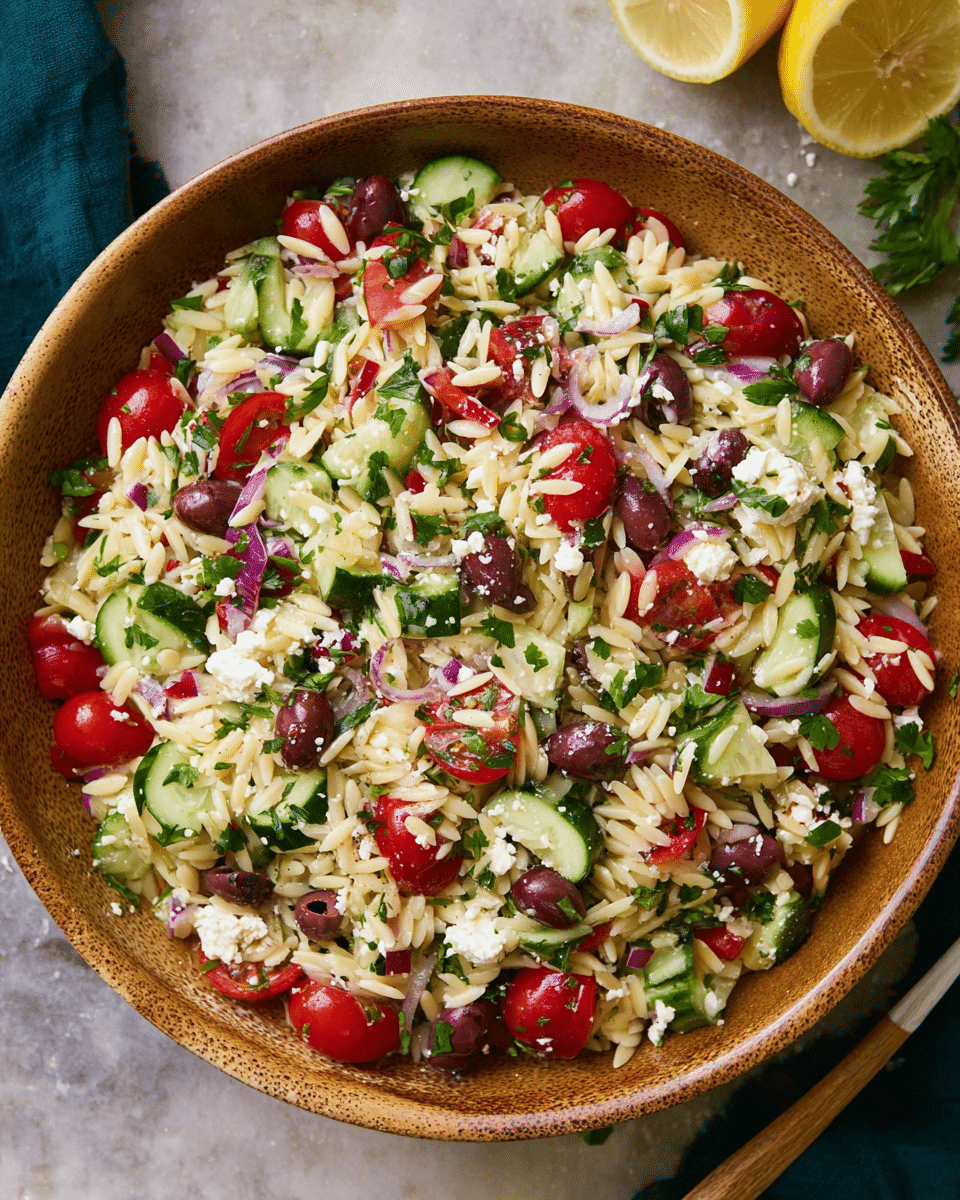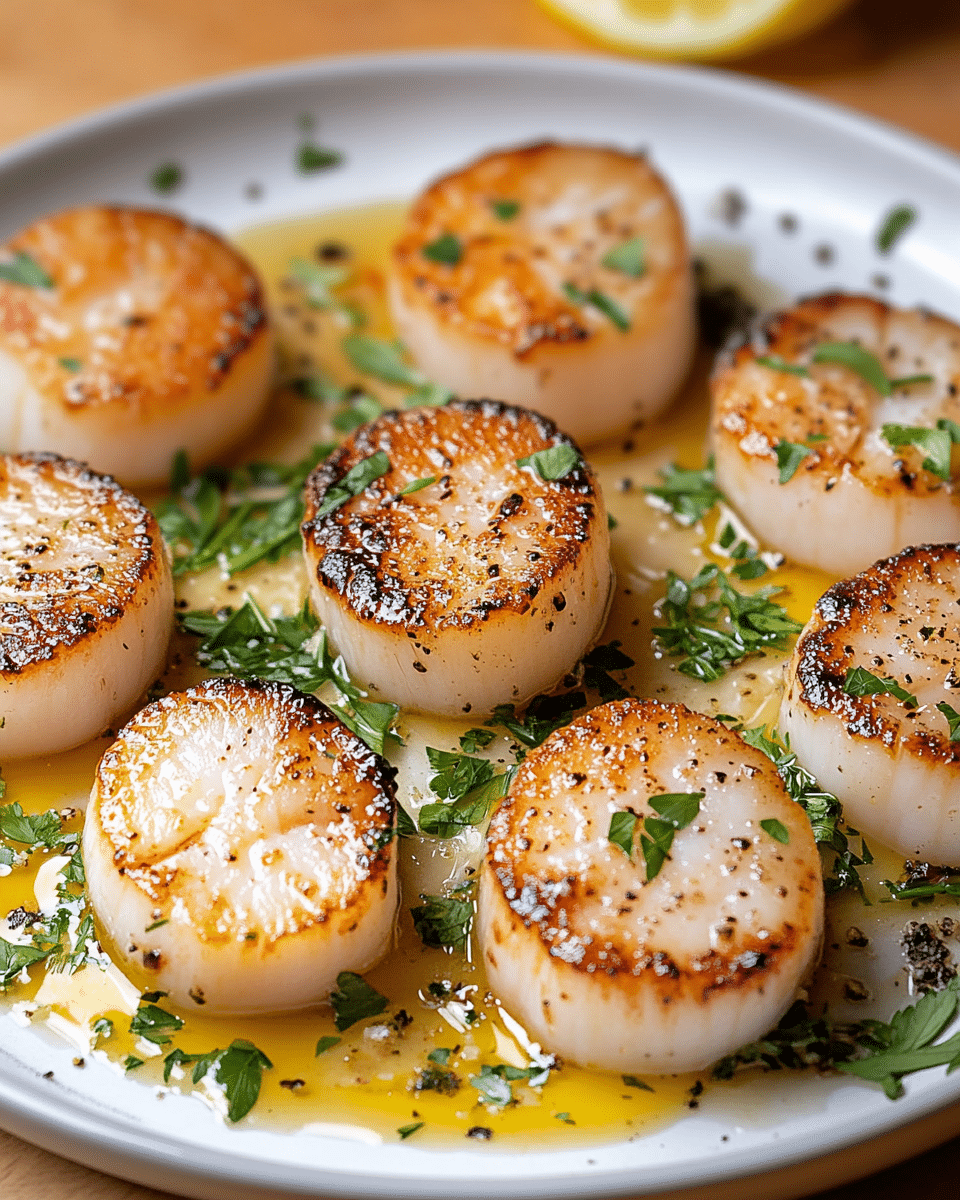A vibrant and refreshing Greek Orzo Pasta Salad, perfect for a light lunch or as a flavorful side dish at any gathering. This salad combines tender orzo pasta with crisp veggies, tangy feta cheese, and a zesty lemon-oregano dressing for a Mediterranean twist.
FULL RECIPE
Ingredients
- 1 ½ cups orzo pasta
- 1 cup cherry tomatoes, halved
- 1 cucumber, diced
- ½ red onion, finely chopped
- ½ cup Kalamata olives, pitted and sliced
- ½ cup crumbled feta cheese
- ¼ cup fresh parsley, chopped
- 3 tablespoons extra virgin olive oil
- 2 tablespoons fresh lemon juice
- 1 teaspoon dried oregano
- Salt and black pepper, to taste
Directions
- Cook the orzo pasta according to package instructions until al dente. Drain and rinse with cold water to cool.
- In a large bowl, combine the cooked orzo, cherry tomatoes, cucumber, red onion, olives, feta cheese, and parsley.
- In a small bowl, whisk together the olive oil, lemon juice, oregano, salt, and pepper.
- Pour the dressing over the salad and toss gently to combine. Adjust seasoning as needed.
- Chill in the refrigerator for at least 30 minutes before serving for best flavor.
Nutritional Information
- Calories: 280 kcal
- Protein: 7 g
- Carbohydrates: 32 g
- Dietary Fiber: 3 g
- Sugars: 4 g
- Fat: 13 g
- Saturated Fat: 3.5 g
- Cholesterol: 15 mg
- Sodium: 480 mg
- Vitamin A: 10% DV
- Vitamin C: 20% DV
- Calcium: 15% DV
- Iron: 10% DV
The History and Origin of Greek Orzo Pasta Salad
Greek Orzo Pasta Salad is a modern adaptation inspired by traditional Greek cuisine, which is celebrated for its fresh, wholesome ingredients and vibrant flavors. Orzo, a rice-shaped pasta, originally comes from Italian culinary traditions but has been embraced by Greek cooks for its versatility and ability to absorb dressings and flavors. This salad blends Mediterranean staples like olives, feta cheese, and fresh vegetables with orzo to create a dish that captures the essence of Greece’s culinary heritage while catering to contemporary tastes.
Nutritional Benefits of Key Ingredients
This salad is not only delicious but packed with nutrition. Orzo provides a good source of carbohydrates for energy, while cucumbers and tomatoes contribute hydration and important vitamins such as vitamin C and antioxidants. Feta cheese adds protein and calcium, essential for bone health, and Kalamata olives bring heart-healthy monounsaturated fats and antioxidants. The olive oil dressing further enhances the dish’s nutritional profile by providing healthy fats and anti-inflammatory compounds.
The Role of Orzo in Mediterranean Diets
Orzo, although technically pasta, is often used in Mediterranean cooking as a grain substitute. It fits well within the Mediterranean diet, known for its focus on whole foods, vegetables, legumes, nuts, healthy fats, and moderate dairy consumption. This pasta salad exemplifies the diet’s principles by combining nutrient-rich ingredients that promote heart health, weight management, and longevity, making it a great choice for health-conscious eaters.
Flavor Profile and Texture Combination
One of the standout features of Greek Orzo Pasta Salad is its balance of flavors and textures. The orzo’s soft, tender bite contrasts beautifully with the crisp cucumbers and juicy cherry tomatoes. The salty, tangy feta cheese and briny Kalamata olives provide bursts of intense flavor, while the lemon-oregano dressing ties everything together with its bright, herbal notes. This variety of textures and tastes keeps each bite interesting and satisfying.
Versatility and Serving Suggestions
This salad is incredibly versatile, making it suitable for numerous occasions. It works well as a light lunch, a side dish at barbecues or picnics, or even as a healthy appetizer. It can be served chilled or at room temperature, making it easy to prepare ahead. For a heartier meal, you can add grilled chicken or shrimp. It also pairs wonderfully with other Mediterranean dishes such as grilled vegetables, pita bread, or tzatziki sauce.
How to Customize Your Greek Orzo Pasta Salad
The beauty of this recipe lies in its adaptability. You can easily adjust ingredients to suit your preferences or dietary needs. For example, swapping out feta for vegan cheese or adding more fresh herbs like dill or mint can change the flavor profile. You can incorporate different vegetables, such as bell peppers or artichoke hearts, or add nuts like toasted pine nuts or walnuts for extra crunch. The dressing can be tweaked by adding garlic or using red wine vinegar for a sharper tang.
Storing and Preparing Ahead
Greek Orzo Pasta Salad holds up well in the refrigerator, making it an excellent choice for meal prepping or preparing in advance for events. The flavors tend to meld and improve after sitting for a few hours. However, to maintain the freshness of the vegetables and avoid sogginess, it’s best to add delicate ingredients like fresh herbs or certain cheeses right before serving. Stored in an airtight container, it can last for 3 to 4 days.
Pairing with Beverages
This salad pairs excellently with a variety of beverages that complement its bright and fresh flavors. Traditional Greek wines, such as a crisp Assyrtiko or a light Rosé, highlight the salad’s citrusy and herbaceous notes. For non-alcoholic options, sparkling water with lemon or a refreshing iced tea with mint makes an ideal accompaniment, enhancing the Mediterranean dining experience.
Dietary Considerations and Modifications
For those with dietary restrictions, Greek Orzo Pasta Salad can be easily modified. Gluten-free orzo alternatives made from rice or corn can replace traditional wheat pasta to accommodate gluten intolerance. The recipe is naturally vegetarian and can be made vegan by substituting feta cheese with a plant-based alternative or omitting it altogether. It’s also low in added sugars and rich in fiber, making it suitable for many health-conscious diets.
Cultural Significance of Ingredients
Each ingredient in the salad holds cultural significance in Greece. Feta cheese, known as the national cheese of Greece, has been made for centuries using traditional methods. Kalamata olives are celebrated for their distinctive flavor and historical cultivation in the region. Fresh herbs like oregano are staples in Greek cooking, often symbolizing hospitality and health. Incorporating these ingredients brings an authentic taste and cultural connection to the dish.
The Environmental Impact of Mediterranean Ingredients
Choosing Mediterranean staples such as olive oil, fresh vegetables, and legumes contributes to a more sustainable food system. These ingredients typically require less intensive farming compared to processed foods and red meats. Emphasizing plant-based foods and healthy fats in meals like Greek Orzo Pasta Salad supports both personal health and environmental well-being, aligning with growing global trends toward sustainable eating.
Tips for Making the Perfect Dressing
The dressing is a crucial component that brings all the flavors together. Using fresh lemon juice rather than bottled, high-quality extra virgin olive oil, and fresh or well-preserved dried oregano ensures the best taste. Balancing acidity with a pinch of salt and a little black pepper enhances the flavor without overpowering the salad’s natural ingredients. Whisking the dressing thoroughly helps to emulsify it, coating every ingredient evenly.
Conclusion
Greek Orzo Pasta Salad is more than just a simple dish; it’s a celebration of Mediterranean flavors, culture, and nutrition. Its combination of wholesome ingredients provides a balanced meal option that’s both satisfying and healthy. Whether you’re looking for a light lunch, a side dish, or a make-ahead meal, this salad offers versatility, ease of preparation, and vibrant taste. Its rich cultural roots and nutritional benefits make it a perfect addition to any menu or lifestyle focused on fresh, flavorful, and wholesome eating.








